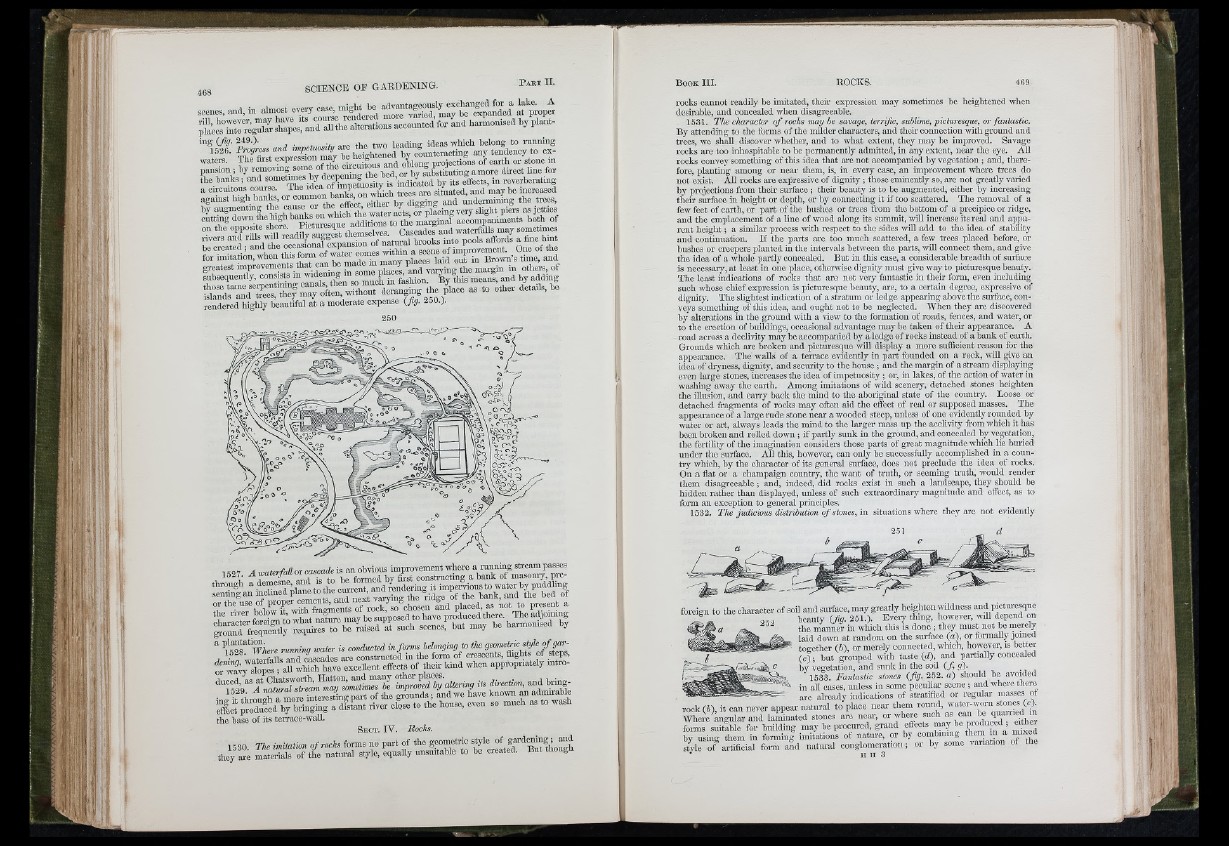
- .-■ P '-
1 s
[ f ita
r '%
Í r t ?
J Li
l ) , I
" %
ré ''
l ' ? ! r é i,.:
i t a r é i i è i *
ta ita '
■ f
Í 1 Ú 1 : Yiil
* ré
¡
I Í ’
ï
m
A
i ’
ing (fg - 2i9-)- , , w fiinE ideas wliich belong to running
i l i i l l g B
9 ^ m m m r n f » —
as to other details, bo
rendered highly beautiM at a moderate expense (fig. 250.)-
250
idge of the bank, and the bed of
the base of its terrace-waU.
Sect. IV. Bochs.
rocks cannot readily he imitated, their expression may sometimes be heightened wlicn
desirable, and concealed when disagi-eeable.
1531. The character o f rocks may be savage, terrific, sublime, picturesque, or fantastic.
By attending to the forms of the milder characters, and their connection with ground and
trees, we shall discover whether, and to what extent, they may he improved. Savage
rocks are too inhospitable to be permanently admitted, in any extent, near the eye. All
rocks convey something of this idea that arc not accompanied by vegetation; and, therefore,
planting among or neai* them, is, in every case, an improvement where frees do
not exist. All rocks are expressive of d ignity; those eminently so, are not greatly varied
by projections from their surface; thefr beauty is to be augmented, either by increasing
their surface in height or depth, or by connecting it if too scattered. The removal of a
few feet of earth, or part of the bushes or trees from the bottom of a precipice or ridge,
and the emplacement of a line of wood along its summit, will increase its real and apparent
h e ig h t; a similar process with respect to the sides will add to the idea of stability
and continuation. I f the parts are too much scattered, a few trees placed before, or
bushes or creepers planted in the intervals between the parts, will connect them, and give
the idea of a whole partly concealed. But in this case, a considerable breadth of surface
is necessary, at least in one place, othenvise dignity must give way to pictm-esque beauty.
The least indications of rocks that are not very fantastic in thefr form, even including
such whose chief expression is picturesque beauty, are, to a certain degree, expressive of
dignity. The slightest indication of a stratum or ledge appearing above the sm-face, conveys
something of this idea, and ought not to be neglected. When they are discovered
by alterations in the ground with a view to the foi-mation of roads, fences, and water, or
to the erection of buildings, occasional advantage may be taken of thcir appearance. A
road across a declivity may be accompanied by a ledge of rocks instead of a bank of earth.
Grounds which are broken and picturesque will display a more sufficient reason for the
appearance. The walls of a terrace evidently in part founded on a rock, will give an
idea of dryness, dignity, and security to the house; and the margin of a stream displaying
even large stones, increases the idea of impetuosity; or, in lakes, of the action of water iu
washing away the earth. Among imitations of ivild scenery, detached stones heighten
the illusion, and can*y back the mind to the aboriginal state of the country. Loose or
detached fragments of rocks may often aid the effect of real or supposed masses. The
appearance of a large nide stone near a wooded steep, unless of one evidently rounded by
water or ait, always leads the mind to the larger mass up the acclivity from which it has
been broken and rolled down ; if partly sunk in the ground, and concealed hy vegetation,
the fertility of the imagination considers those parts of great magnitude which lie hm-ied
under the surface. All this, however, can only be successfully accomplished in a coun-
ti-y which, by the character of its general surface, does not preclude the idea of rocks.
On a flat or a champaign countiy, the want of trath, or seeming truth, would render
them disagreeable; and, indeed, did rocks exist in such a landscape, they should be
hidden rather than displayed, unless of such extraordinary magnitude and effect, as to
foi-m an exception to general principles.
1532. Tke judicious distributim o f stones, in situations where they are not evidently
foreign to the character of soü and surface, may gi'eatly heighten wildness and pfeturesque
beauty (fig. 251.). Eveiy thing, however, will depend on
the manner in which this is done ; they must not be merely
laid do-wn at random on the surface (a), or formally joined
together (b), or merely connected, which, however, is better
(c ); but grouped with taste (c/), and partially concealed
by vegetation, and sunk in the soil ( f , g).
1533. FanUistic stones (fig. 252. a) should be avoided
in all cases, unless in some peculiar scene ; and where there
------------— =— ------ already indications of stratified or regular masses ot
r o c k ® , it can never appear natural to place neai- them JZ e L ^ ^ ^
Where angular and laminated stones are near, or where such as can ?
forms suitable for building may be procured, grand effects may be pi oduced either
by using them in forming imitations of nature, or by combining “ om n a mixed
Sfyle of artificial form and natural conglomeration; or by some variation of the
I I II 3